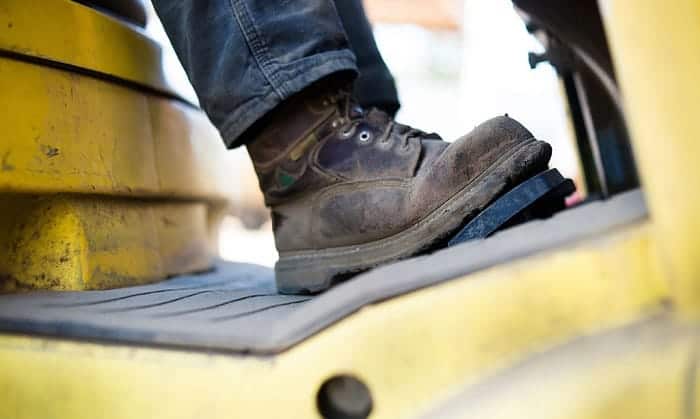Since steel toe boots were introduced, the world of safety gear has been taken to the next level. The steel toe cap acts as a protective reinforcement that prevents many types of injuries, such as falling objects, slips and falls, cuts, burns, punctures, and compression.
As such, they are crucial at hazardous workplaces. Besides, The Department of Labor OSHA (Occupational Safety and Health Administration) requires certain workplaces’ employees to wear safety work boots.
If you need steel-toe boots for work, learning the weight of boots will be helpful to know what you are dealing with. In general, a steel toe work boot weighs from 4 to 4.5 pounds. However, it’s hard to get an exact answer as the weight depends on many other factors like the designs, manufacturers, materials, sizes, and shapes.
In this article, we will provide a detailed answer to the question of how much do steel toe boots weigh? Plus, how materials and other features affect a steel toe boot’s weight.
Table of Contents
How Much Do Steel Toe Boots Weigh
The short answer is they are heavier than regular work boots but will not necessarily weigh down your feet. Due to the protection functions, steel toe boots are heavy-duty and sturdy. On average, a work boot weighs from 2 to 3 pounds. Meanwhile, the weight of a steel toe boot is from 4 to 4.5 pounds, which almost doubles that of a regular one.
Traditionally, the cap is made of steel, but nowadays, designers might use other composite materials like plastic or aluminum to reduce the shoe’s weight. These composite toe boots usually weigh less than the steel toe ones, from 1 to 2 pounds.
So you always have other options if steel toe boots are too much for you. You can watch this video about top ten lightweight work boots for more suggestions. However, we don’t recommend you choose the other materials only for the sake of being lightweight, as steel is the most reliable when it comes to safety.
Also, the weight of a boot depends on multiple other factors, such as size, design, or the sole’s materials. A large size boot can weigh up to 6 pounds. Keep reading to learn more.
How Do Materials and Other Features Affect the Boots’ Weight
Materials have a significant impact on the overall weight of a boot. However, remember that designers always have their reasons for choosing a material. For example, a more weighty type of fabric might last longer and provide better protection. Here are four popular materials designers use:
- Leather: Despite developments in synthetic materials, leather remains popular for many reasons. Firstly, they are breathable and comfortable while making a fashion statement. Leather boots look modern and sophisticated. Secondly, leather is easy to work with. It can be coated, colored, cut, and shaped with minimal effort. Most importantly, they are sturdy and super long-lasting. All of these come with a price that leather boots are relatively heavy. They might usually weigh up to 4 pounds.
- Suede: Suede is also known as split leather. It is because to make suede, the underside of animal skin leather has to be separated from the top. This helps the material to be much lighter, thinner, and softer than regular leather. On average, suede work boots weigh around 3 to 4 pounds.
- Plastic: Plastic is well-known as a lightweight material, and it is true in this scenario. Plastic work boots are the most light-weighted ones, only less than a pound per boot. However, it’s hard to say whether the plastic can elevate a look. Plus, plastic is not stretchy or breathable. You will find it highly uncomfortable when wearing plastic boots for a prolonged period of time. The most popular use of plastic work boots is farming and as rain boots.
- Fabric: Historically, designers invented fabric work boots when realizing how weighty leather safety boots can be. Steel toe fabric boots are light and nimble. They offer better flexibility and comfort for the wearer. Maximally, a pair of fabric boots weighs around 4 pounds, which means 2 pounds per boot. However, in terms of durability and sturdiness, they are not as good as leather and suede boots.
Besides materials, many other features in a work boot can affect its weight:
- Padding: Paddings are from foam or other material. They are usually inserted inside the boots to add cushioning. Even though paddings are light foam, they do add a bit of extra weight to the boot. If you see a boot labeled as anti-fatigue, slip resistance, or shock absorption, chances are it is thicker and heavier than a regular steel toe work boot.
- Shank: Many work boots feature a steel shank. It helps minimize injuries in the event of penetration by sharp objects and provides foot support. Similar to a steel toe cap, a shank is made from a variety of materials, such as steel, fiberglass, wood, nylon, and plastic. Again, among all materials, steel is the most heavy, but metal is much more durable and sturdy.
- Insulation: As said in the name, insulated work boots feature extra layers and materials to keep you warm and comfortable during freezing weather. If you are looking for insulated work boots, remember that they are always heavier than regular safety boots.
Conclusion
Even though steel toe boots are not the most flexible and light-weighted ones in the market, they are preferred when it comes to safety. You can always rely on these to prevent injuries at hazardous workplaces. Steel toe boots are imperative for heavy-duty workers. Therefore, consider the risk levels at your job carefully before choosing safety work boots, and do not choose other materials only for the reduced weight.

Having worked in the field of personal protective equipment for over two decades, Andrew Carnegie is a specialist in the field.
At EDC, he strives to improve performance efficiency and promote workplace safety for EDC’s readers and customers. He also researches the most up-to-date equipment that has earned relevant accreditation for use in a wide range of industries and specialties.




